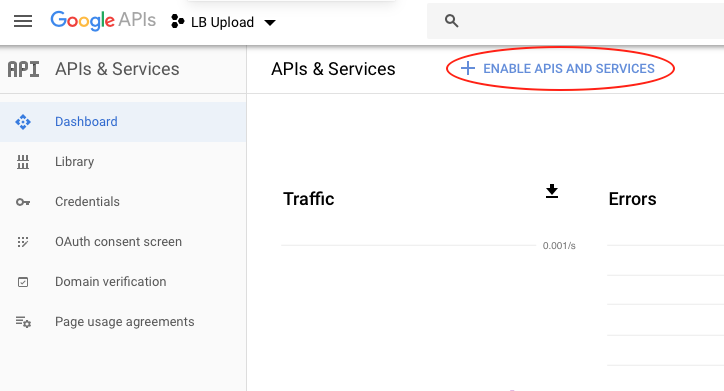by Gregory Bruno | May 21, 2020
May 21, 2021
Live Blog: The ‘Missing Link’ for Norway’s Sports Fans

Live Blog: The ‘Missing Link’ for Norway’s Sports Fans
Norwegians love live sports. In 2019, for instance, more than 1.2 million people – nearly a quarter of the country – tuned in to watch Norway dominate the FIS Nordic World Ski Championships (Norway won 25 medals that year; Germany, in second place, took home just nine).
For print and online news producers – in Norway and far beyond – live sporting events present a coverage quandary: how can their journalists deliver content that audiences want even as broadcasters deliver the action in real time to people’s living rooms? At NTB, Norway’s leading news agency, the answer lies in Live Blog.
NTB’s sports journalists have begun using Live Blog to supplement the news agency’s live event coverage blogs with in-depth analysis, multimedia, and long-form reporting. Terje Alstad, Head of Sports Data at NTB, says when done properly, a live blog provides content that broadcasters cannot.
“When you have photographers or journalists on site, they can send whatever they have into the Live Blog feed,” says Alstad. “For example, if a Norwegian skier was angry that he didn’t get a medal, our photographers might capture a photo of the guy throwing his helmet, which can give readers of the Live Blog fresh insight and on-the-ground colour.”
NTB Sports is also using Live Blog to share stories from the new agency’s wire that might be of interest to sports fans following live event coverage – like a regular article from the race, a feature story, or a photo essay.
Until now, live blogs played more of a supporting role in the news agency’s sports coverage. Data from the Norwegian Football Federation, for instance, is fed into NTB’s internal backend and delivered to clients as box scores and automated stories; Nettavisen, one of Norway’s most popular online news sites, uses NTB data to power its football live blog. But last year, after NTB set up an easy integration between Superdesk, the newsroom’s open-source CMS, and Live Blog, to report on the constant flow of Covid-19-related news, other desks within the news agency started to take notice. NTB’s Sports Desk has been among the most ardent converts.
Today, Alstad says NTB is delivering its enhanced sports Live Blog content to some of the country’s largest news publishers, including Nettavisen and Dagbladet. Even TV broadcasters have signed up. NTB is a “third party for TV 2,” says Alstad, meaning that NTB’s “reporters are choosing and sending stories to the broadcaster for inclusion in their live blog so that TV 2’s editors don’t have to.”
Alstad adds: “This integration between Superdesk and Live Blog has improved our sports coverage; it is kind of the missing link for our live blogs. Now, we can supplement our live event coverage with interviews and other stories, material that can be managed by editors on the desk. With this extra content capability, Live Blog’s usefulness has been extended.”
Looking for a better live blogging solution? Try out Live Blog from Sourcefabric for seven days free, no strings attached. Get your trial version here.
April 28, 2021
Building New Real-Time News Products

Building New Real-Time News Products
by Gregory Bruno | April 28, 2020
Since launching its Covid-19 Live Blog early last year, NTB, Norway’s leading news agency, has continued to integrate the live blogging platform into its editorial workflow.
New Live Blogs have included a December 2020 feed to report on the aftermath of a massive landslide near Oslo, and another in January to report on the riots at the US capital.
For editors in Oslo, this has enabled more immersive storytelling, bringing clients and their readers richer content in a more efficient, streamlined process.
“In the last year we’ve been a lot more focused on news bulletins and live coverage,” says NTB technology and development editor Magnus Aabech, who is spearheading the agency’s live blogging strategy. “The format itself has become really important for NTB based on client feedback. And, with the Superdesk-Live Blog integration that we launched in early 2020, we can give clients what they want in an easy-to-digest and publish format.”
Replicating Benefits: Building New Products and Services
Because the integration with Live Blog is CMS-agnostic – it can be configured with any content management system – news producers of any size can use the Live Blog platform in much the same way as NTB. For instance, if a news agency or other content creator was covering their region’s elections, stories from their CMS could be published to their Live Blog via an API, and this content could then be syndicated to subscribers as an extra service.
This is exactly what the NTB Sports Desk is doing. During the FIS Nordic World Ski Championships this winter, an NTB reporter worked the event live, providing readers with real-time coverage of the races and events. Editors, meanwhile, were able to feed the Live Blog with articles and features sent directly from the CMS. And because Live Blog enables multiple users to work together on a single blog, NTB’s photographers were able to file their pictures directly to the Live Blog, providing on-the-ground insights that not even the television networks could manage.
Together, this collection of live updates, fresh photos, and in-depth reporting gave readers comprehensive coverage of one of skiing’s most important annual events. It also became another product NTB offers its customers.
“The Live Blog integration with our CMS has given us a new area of publishing capability,” says Aabech. “Live Blog is customisable and can do a lot of the work for us. Even internally, it’s been a great way to get people to think more visually about the content we distribute.”
NTB’s Live Blog Journey
When the coronavirus pandemic hit Norway, NTB turned to Live Blog as a means to distribute content quickly and in a more targeted fashion. As Norway’s biggest news agency, NTB’s bread and butter is short wire reports and breaking news, content that was being produced at a rapid clip during the height of the outbreak. But most of NTB’s clients – newspapers, news websites, and other traditional publishers – could only make use of a fraction of the agency’s output. There were simply too many stories on the wire for a news publisher to slot into their website in real-time.
To solve this challenge, NTB technologists, working with Sourcefabric, developed a simple configuration to connect Superdesk, the newsroom’s CMS, with Live Blog, our professional live blogging platform. The goal was to make it easy for NTB’s content users to integrate curated blog feeds into their own website, eliminating the need to trawl the NTB wire and update content throughout the day. Clients could either embed the NTB Live Blog feed directly into their website, or, by using an API, adjust the look and feel of the NTB Live Blog to match their own visual brand.
“Live Blog has allowed us to provide our clients and subscribers with richer content, mixing photos, graphics, and visually driven elements in a single feed,” says Aabech. “It’s really been a great way to tailor content to our clients’ needs, and to find new ways to deliver our journalism.”
To do more with less, news organisations need tools that increase efficiencies and streamline content output. Tools like Live Blog can help.
Looking for a better live blogging solution? Try out Live Blog from Sourcefabric for seven days free, no strings attached. Get your trial version here.
November 25, 2020
Using A Live Blog for Black Friday Deals

Using Live Blog for Black Friday Deals
by The Live Blog Team | November 25, 2020
Once Black Friday was only part of the holiday shopping season for retailers. Today it triggers major consumer activity for anyone in the content business: not only when readers make purchases, but also for reading reviews and checking out what the trends and must-have items are for the season. That’s why Black Friday can be a big opportunity for publishers too.
Brands, retailers and news media all benefit from the extra attention that consumers pay to their favourite websites on the last Friday in November in search of deals on the stuff they want to get or gift. Typically those must-have items span a range of categories, from electronics and household goods to makeup and fashion, each offered by a variety of retailers or websites.
Using a live blogging platform as a real-time deal ticker, publishers can present all of the latest promotions in one place. Here are some examples from around the web:
And this year, with brick-and-mortar stores closed or at limited capacity, customers will be doing most of their holiday shopping online. Publishers can benefit from this trend by inking an affiliate or referral agreement with retailers.
How a Black Friday live blog works
A Black Friday live blog is one part editorial curation and one part affiliate marketing.
Publishers can either earn a commission when readers go on to visit a retailer’s storefront from the deals mentioned on the live blog, or sell paid placements directly. Another benefit to publishers’ websites is the increase in traffic. One publisher told us that their Black Friday Live Blog, and the live video that goes with it, boosts traffic by 43% on Black Friday over their daily average of 700,000 daily readers.
Readers not only see it as a service, but also a fun read they enjoy spending time on. In particular, they may appreciate the personal touch added by a blog’s editors.
Live blogging special deals year round
The official week of Black Friday runs from the last Monday of November to the first Monday of December. However, savvy editors start adding the pre-holiday promotions as early as late September for those deal-hunters who never stop searching for the best bargain.
How can Live Blog boost your content monetisation strategy? Get in touch with us for a personal consultation.
July 23, 2020
Live Blog’s New Tagging Functionality for Digital Publishers

Live Blog’s New Tagging Functionality for Digital Publishers
by Todd Jatras | July 22, 2020
The recent release of Live Blog 3.8 introduced a new tagging feature that improves the discoverability of live blogging content for digital news publishers and their readers.
Previously, it was only possible to search on the content within a timeline by three criteria: newest, oldest, and editor’s choice. But editors can now create and apply as many tags as they want to each post as it’s published, making posts within a blog timeline searchable on a granular level.
Readers will now see an additional dropdown menu, labeled Filter Content, that displays all the available tags they can search on. If, to use one example, a reader of a blog on Premier League football was a fan of Liverpool F.C. and was interested only in items relevant to their team, they could pull down the menu, find their team’s name, select it, and the blog timeline would only display Liverpool-related posts.
To create tags to include in a post, go to Live Blog’s General Settings (see image below) and type them into the Global Tags dialogue box. If a term is not already there, you will be given the option to create that tag. These tags are global, and once they’ve been created they will be available to all the different timelines within a publisher’s blogging portfolio.
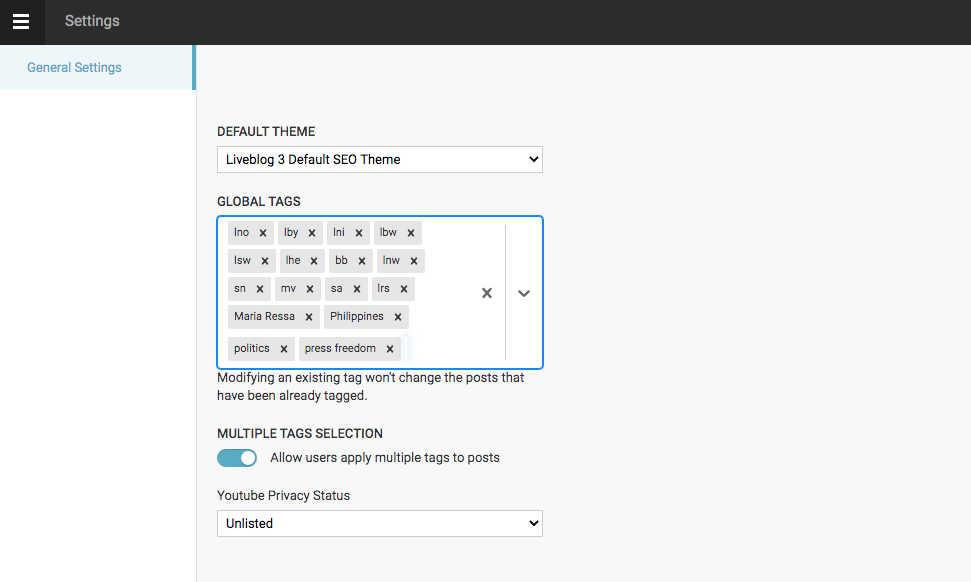
To apply these tags, there is a Tag(s) dialogue box in the editor field, on the bottom of each post. Type in the first few letters of the desired tag, and the predictive text will list available tags below it based on that criteria. In the example below “pr” brought up “press freedom” (highlighted in blue). Select the tag(s) you want, and click update. If the tag you’re looking for is not there, go to General Settings and add it.

When looking at the same post live, from the reader’s perspective (see below), the “press freedom” tag we just created appears under Filter Content.

When the reader selects that tag, only content containing that term will be displayed in the blog timeline.
This new level of search granularity is convenient for both readers, who may be interested in dipping far back into their favourite blog’s archive, and publishers looking to get a better handle on their overall blog content production.
Want to see what Live Blog can do for your publication? Sign up for your free trial here.
July 1, 2020
Live Blog’s New Tagging Functionality: Better Syndication and Content Discoverability

Live Blog’s New Tagging Functionality: Better Syndication and Content Discoverability
by Todd Jatras | July 01, 2020
With the release of Live Blog 3.8, we’ve introduced local and global tagging functionality that streamlines the process of syndicating blog content for news agencies and their clients.
Until now, it was only possible to filter content within a timeline based on three options: newest first, oldest first or editor’s choice. This was useful for readers following a story, but limiting for news outlets looking for posts relevant to their audience. Editors had to wade through what could be a sea of posts to find what they were looking for. But users now have a drop-down menu that displays the list of tags editors have assigned to a specific blog, and can find appropriate content by filtering on these tags.
In addition to global tags that can be applied across Live Blog instances, editors can also create and apply local tags to individual posts within a timeline. Then, using these tags, they can filter content and create syndication channels for news topics based on single or multiple preset tags. (Note: Using global or local tags is an either-or decision; it is not possible to use both at the same time.)

Creating and applying tags across instances or within timelines is now a standard Live Blog syndication feature.
For instance, if an agency is running a live blog on the coronavirus outbreak in Europe, editors could tag each post within that blog timeline according to location or region (Germany, Austria, Norway, etc.) and media outlets in those countries would be able to identify appropriate items by filtering with their relevant tags.
Some of our Live Blog clients, such as German news agency DPA, have dozens of live blogs going at a time, and are constantly adding new ones as big news stories break that require live coverage.
Finding particular topics among all of those blogs was the goal of introducing tag-based filtering in the latest Live Blog release. Now, news agencies and their clients can search across blog instances and within individual blog timelines, and set up more targeted syndication output channels. With an embed link created on the back end of Live Blog, clients will only see the content that has been filtered based on those tags.
If you are not yet a Live Blog user and you’re looking for live blogging software to cover real-time news, you can try Live Blog for free here, no strings attached.
March 26, 2020
How To Upload Videos to YouTube Directly from Live Blog

How To Upload Videos to YouTube Directly from Live Blog
by Todd Jatras | Mar 26, 2020
There are many reasons why you should be using videos in your live blogs, chief among them is providing readers with a fuller, visual perspective on the story at hand. Adding videos to your timeline also has an immediate impact on SEO efforts, as search engines tend to give a higher ranking to pages containing rich media, which in turn drives higher organic traffic and reader engagement. Our live blogging software gives you the option to do exactly that.
With that in mind, our recent release of Live Blog 3.6 included the ability to link your blog to a YouTube account and set it up to simultaneously upload videos there as you post them to your timeline.
Read on for a step-by-step guide to linking your Live Blog and YouTube accounts in five easy steps.
Step 1:
First, to set this up successfully, you will need to have administrative access for your Live Blog instance. You also need to have an active Google/YouTube account. Since Google own Youtube, you must have a Google account to set up Youtube. If you don’t already have an account, go to google.com and register for one, then sign in and go to https://console.developers.google.com/.
Step 2:
On the top left-hand side of this page (see below), pull down the “Select Project” menu and click “NEW PROJECT”. In the “Project name” field, give your project an easy-to-remember name like “LB YouTube”, then click the “CREATE” button.

Step 3:
On the Google console page, click “+ENABLE APIS AND SERVICES” (below), which takes you to the API Library page. Scroll down the page and select “YouTube API v3”, then click the “ENABLE” button.
Step 4:
Now go to Credentials under APIs & Services (see below), click the “+CREATE CREDENTIALS” menu at the top of the page and select “OAuth client ID”. For application type, select “web application”. In the “Authorized redirect URLs” field, enter the redirect URL for your Live Blog instance (example: https://demo.liveblog.pro/api/video_upload/oauth2callback) and click the “CREATE” button. Do not include a backslash on the end of the URL or you will receive an error message.
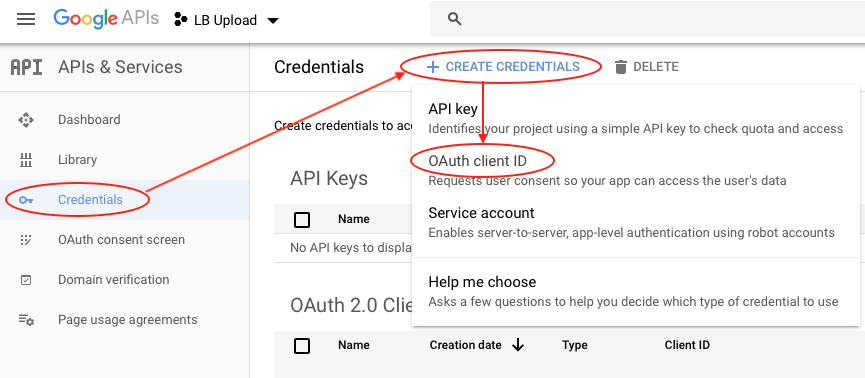
Step 5:
Now that you have YouTube credentials (Client ID and secret code), download the file containing them by clicking the “DOWNLOAD JSON” button on the top of the page or the arrow down icon. Finally, go to Live Blog (see below), choose any blog you’ve created there (see below) and click “ADD CONTENT HERE”, select “Video”, then click “UPDATE CREDENTIALS” and follow the directions to upload the JSON file you downloaded.
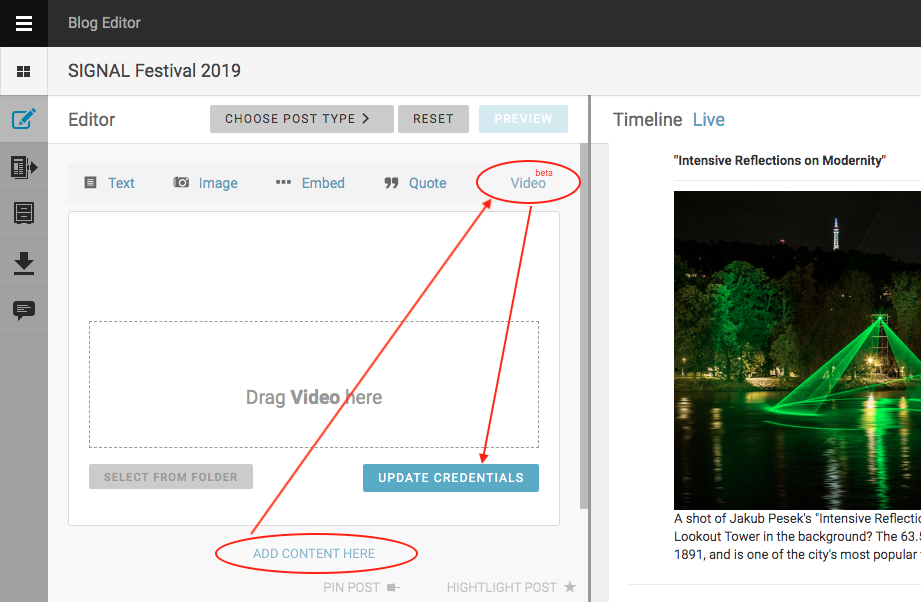
And there you have it. Now, when you post a video to your timeline by dropping it into the “Drag Video here” zone (above), it will be automatically uploaded to your YouTube account.
If you are not yet a Live Blog user and you’re looking for live blogging software to cover real-time news, you can try Live Blog for free here, no strings attached.
January 23, 2020
Guide to Live Blogging: Everything you need to know

Guide to Live Blogging: Everything you need to know
by Greg Bruno | September 20, 2024
In today’s news cycle, there’s no time for down time: live blogs are one of the best ways to deliver information quickly. But what, exactly, is live blogging, and what are live blogs good for, and which live blogging tool should you use? Good questions; here are some answers.
What is a live blog, anyway?
A live blog, sometimes referred to as “live text,” is a blog post that provides a rolling textual coverage of an ongoing event supplemented with images, videos, and other digital material. According to The Guardian: “Live blogs provide commentary and analysis alongside breaking news rather than summarising the event after it is over. It’s a transparent format in which the writers are able to update and amend their commentaries in easily digestible paragraphs.”
Live blogging can be used for a wide variety of events and circumstances – such as sporting events, elections, concerts, award ceremonies and conferences. Although live blogs are constantly evolving, news organisations use live blogs for a number of reasons: to reach wider audiences, to increase the transparency of the traditional news-making process, to increase content engagement, and even to generate new streams of revenue through blog syndication.
Live blogging through the ages
What started in the mid-2000s as a software tool for techies to broadcast technology conferences has since become an essential story format for journalists and other information providers to distribute digital coverage in chronological order.
Personalisation is a live blog’s comparative advantage. Unlike television, which must be watched in a linear way and in real time (although viewers can record it and watch it later), live blogs allow readers to start at any point in the story and reread, save, share, and digest information at their own pace.
Why live blogging?
Live blogs are widely read. In 2012, research by City University London found that live blogs get 300% more views and 233% more visitors than conventional online articles on the same subject. Live blogs also outperform online picture galleries, getting 219% more visitors. In 2013, the Reuters Institute for the Study of Journalism found that readers increasingly prefer live blogs to static content and believe live coverage to be more balanced and neutral. Additionally, 62% of survey takers said live blogs are the best format to consume news at work.
More recent data shows that audiences are spending less time reading full news stories and more time engaging with highlights and breaking news – everything from Steph Curry’s three-point buzzer beater to coverage of natural disasters. In fact, when big news breaks, studies show that readers actively seek out quality information through online search – before content is shared on social media. That’s one reason why having a live blog dedicated to breaking news coverage will boost your site’s profile online.
But the benefits are not limited to the immediate time during and after an event. It turns out that readers go back, again and again, to visit live blog timelines of events in the past. “Our experience is that live blogs drive lots of traffic to our site,” said Sybille Klormann, an editor at Zeit Online covering politics and economics. “We are often surprised at how many people visit these blogs, especially during elections, but also show a continued interest afterwards.”
Bottom line: “Live blogging can be a very valuable resource to your readers if done right,” says professional blogger Cameron Chapman. “If you take the time and keep focused throughout an event to provide useful information to your readers, they’ll often consider your blog the go-to place for event coverage in your industry. If it’s done poorly, though, all those blog posts will likely just be looked at as filler or fluff by your readers, and may even annoy some to the point they unsubscribe from your RSS feed.”
Proven use cases for live liveblogging
Live blogs can be used for covering a wide-array of news stories and banner events – as breaking news, elections, esports, conferences, award shows, and live sports. But even the most niche topics can find an audience with a well-done live blog.
Aleks Vickovich, wealth and legal managing editor at Momentum Media in Australia, says one company publication, ifa (Independent Financial Adviser) used a live blog to cover two weeks of financial hearings in 2018. As a result, ifa saw its new traffic increase by 200%. For a publication with “an extremely niche audience of hard core fans,” Vickovich said the growth made possible with live blog was staggering. “We had something like 60,000 unique visits in the two-week period, which is about twice what we usually get in a month.”
Part of that success is because live blog content is becoming more visible in web searches. Why does this matter? Because when the text of a live blog post appears as native content to search engines, it raises the profile of that news organisation’s coverage in new web searches, and also helps with the site’s overall SEO (search engine optimisation). Live blogs provide fresh, relevant content and increase engagement – essentially, longer session durations – through real-time updates, both of which are important factors in enhancing a website’s search rankings. Additionally, integrating LiveBlogPosting schema can improve a live blog’s visibility by indicating that an article is connected to a live event, helping it stand out in search results.
How to live blog successfully
The Internet is full of tips on how to live blog properly, and it can be a challenge to cut through the digital noise. To help you make the most out of your live blogging activity, we’ve collated some of the best insights from across the industry:
Step #1 | Choose the right live blog software
First you need to pick a live blogging platform that serves your needs. Sourcefabric’s Live Blog is a powerful, professional open-source live blogging tool created for journalists and bloggers on the go. It includes rich media posts – like image slideshows and video streams – as well as custom post types and scorecards for covering sporting events.
Additionally, Live Blog offers easy ways to monetise your coverage with tools to integrate native or remote ads into your live blog’s timeline.
The platform also offers a mobile reporting app (Live Blog Reporter) that allows your live blog team to contribute directly from their mobile phones. The app is particularly useful for events such as protests, concerts, and music festivals, where reporters need to write their live blog on the go, unencumbered by bulky equipment.
Step #2 | Plan your coverage BEFORE you start blogging
Once you’ve got your live blogging software picked out, now you need to think deeply about your topic and your blogging strategy. Start by identifying topics that your audience cares about. Whether it’s an important political debate, a major sports match, or a significant cultural event, choose live blogging topics that align with your readers’ passions and interests. After selecting your topic, develop a strategic approach. Coming up with material ad hoc is not the best practice for maintaining a successful live blog. Even though events unfolding in real time often leave little to no opportunity to prepare, there will inevitably be in-between moments where not much is happening. During these times, it’s important for you to have relevant material prepared in advance, general knowledge on the topic you’re covering, and reliable contacts who can assist you.
Step #3 | Think in terms of editorial resources
Producing a good live blog requires people. Some practical questions to consider: is there enough staff available at that particular moment and are there reporters on the scene able to provide information, verify facts, as well as submit images and videos? If the answer is no, perhaps a live blog isn’t the correct format.
Step #4 | Build in communication and collaboration tools
Using established lines of communication is essential for a time-sensitive format like live blogging. If you have a team of more than one, how will you share information about the blog’s content? Whether it’s a tool like Slack or email, you’ll need a way to exchange ideas and content before it’s posted.
Step #5 | Experiment
Because news consumers have taken a much greater interest in live blogs, the go-to form of storytelling offers endless opportunities for innovating. New organisations use live blogging for boosting audience engagement, increasing transparency in the news-production process, and even to generate revenue. There’s really no end to how a live blog can be deployed.
Live Blog examples
Below you will find a variety of live blog examples from around the web that best illustrate the potential of the format.
Der Tagesspiegel has been using Live Blog to provide continuous real-time updates on the Russia-Ukraine war. Their live coverage keeps audiences informed on breaking news with minute-by-minute developments throughout the conflict, such as military operations, reactions from global readers, and interactive maps.
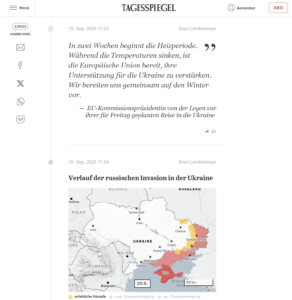
Tagesspiegel implemented Live Blog for real-time insights on the Russia-Ukraine war
Danmarks Idrætsforbund (the National Olympic Committee and Sports Confederation of Denmark) used Live Blog for the Paralympics to deliver real-time reporting of the event. They included a variety of social media content to make their coverage more visual and interactive for readers.
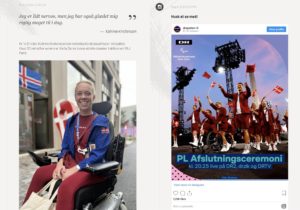
Danmarks Idrætsforbund used Live Blog for their Paralympics’ coverage
The Eurovision Song Contest used the Live Blog platform in the past to manage their live updates, incorporating social media and different forms of multimedia into Eurovision’s overall branding and corporate identity. The live blogging software efficiently handled tens of thousands of concurrent users, allowing the organisers to share highlights of the events and behind-the-scenes content without any technical issues.
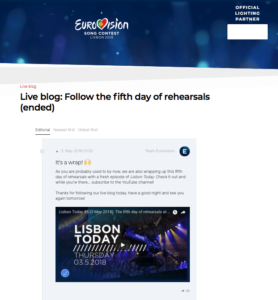
The Eurovision Song Contest’s live blog complemented their branding nicely
The M100 Sanssouci Colloquium is an international media conference held every year in Potsdam, bringing together representatives from traditional, independent, democratic media, alongside voices from politics and science, to discuss current socio-political developments and the media’s role in international affairs. They used Live Blog to provide real-time coverage of the conference, improving discussion and engagement by allowing digital participation and highlighting speaker quotes. The live blogging platform created an accessible, interactive experience for both online and on-site attendees.
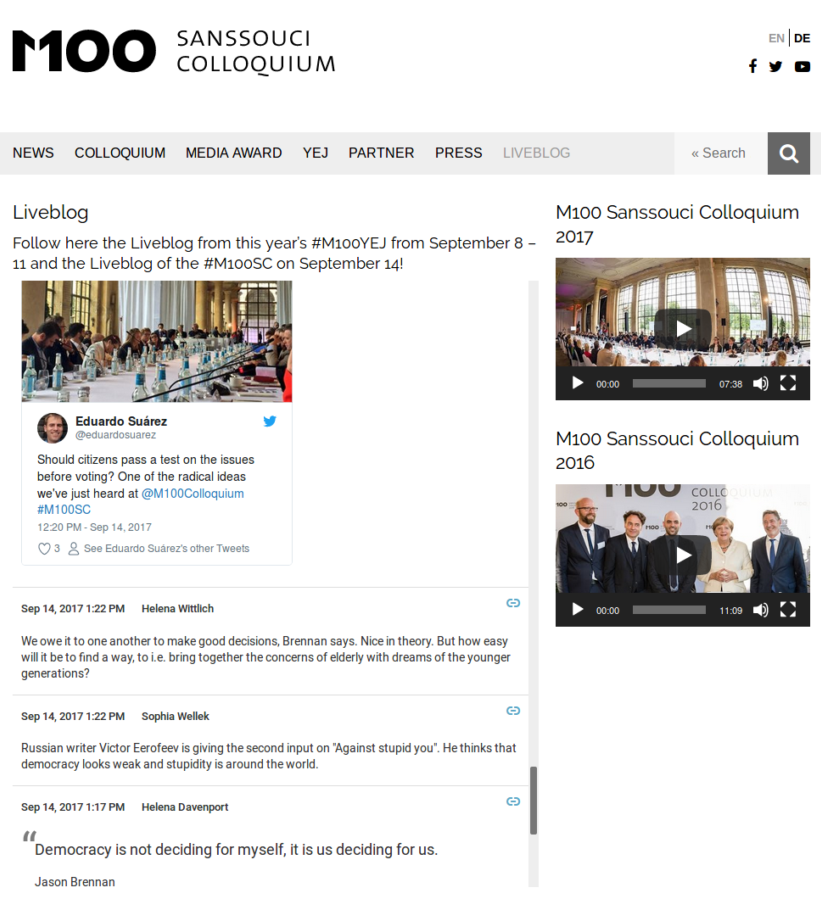
M100 Sanssouci Colloquium used Live Blog for their conference
Frequently asked questions about live blogging
How do I decide what to live blog about?
Select topics that happen in real-time and are of high interest, such as major sports or music events or breaking news. Watch out for trending topics and choose something relevant to your audience.
What makes a good live blog?
A good live blog provides timely updates, accurate and relevant information, and engaging content that keeps readers coming back. Consistent updates and interactive elements, such as polls or a comment section, can improve the overall experience.
How profitable are live blogs?
Live blogs can be profitable depending on different factors such as traffic volume and a good monetisation strategy. Revenue can come from native or remote ads, sponsorships, and premium content.
What are the best topics for live blogging?
Popular topics for live blogging include sports, such as the NBA or the Champions League, major news events, and notable entertainment events like the Oscars or the Eurovision Song Contest. Choose a niche with a broad fanbase and audience. Timeliness and relevance are key.
For Live Blog tutorials, check out our YouTube channel or our blog.
Editor’s note: This post was originally published in 2020 and has been updated in 2024 to include new, relevant insights and information.
January 20, 2020
Mobile Blogging with the Live Blog Reporter App

Mobile Blogging with the Live Blog Reporter App
by Greg Bruno | Jan 20, 2020
In the modern media landscape, audiences expect news when it happens. Live blogs are one of the fastest ways to deliver it, and with our mobile blogging tool, updating readers has never been easier.
In this post (and in the video below) we’re going to demonstrate how to set up and use the Live Blog Reporter App, which gives your blog writers the ability to write and file from anywhere.
We recently tested the app at a pro-democracy protest in Prague to show you how convenient mobile live blogging can be.
1st Step: Install the Reporter App
The first step is to install the Reporter App on the mobile device you want to work from. Search for “Live Blog Reporter” in the iOS or Google Play app stores. Once you’ve got the app on your device, make sure you’re registered as a user and team member for the Live Blog you want to work on. And, if you need a Live Blog instance, visit liveblog.pro to try Live Blog for free.
Once your account is up and running, the next step is to log into the app. On the app’s home screen enter the URL of your Live Blog instance, your username, and your password. Now, locate the blog you want to work on from your organisation’s Blog List. You can only work on blog’s that are bolded; if a name is greyed out it means you don’t have access.
For this tutorial we’ll walk you through how to post images and videos shot from your device to your Live Blog timeline. We’re using images and videos that we took at a huge protest in Prague’s Letna Park in November 2019.
Step 2: Upload an image along with text
When you log into your Live Blog, you’ll be directed to the Editor pane by default. To post an image along with our text, click the “Image” icon on the app’s menu bar. Then select an image from your device’s gallery. Add a description and author information. Finally, save your work by clicking the “check mark” in the upper right-hand corner of the Editor window.
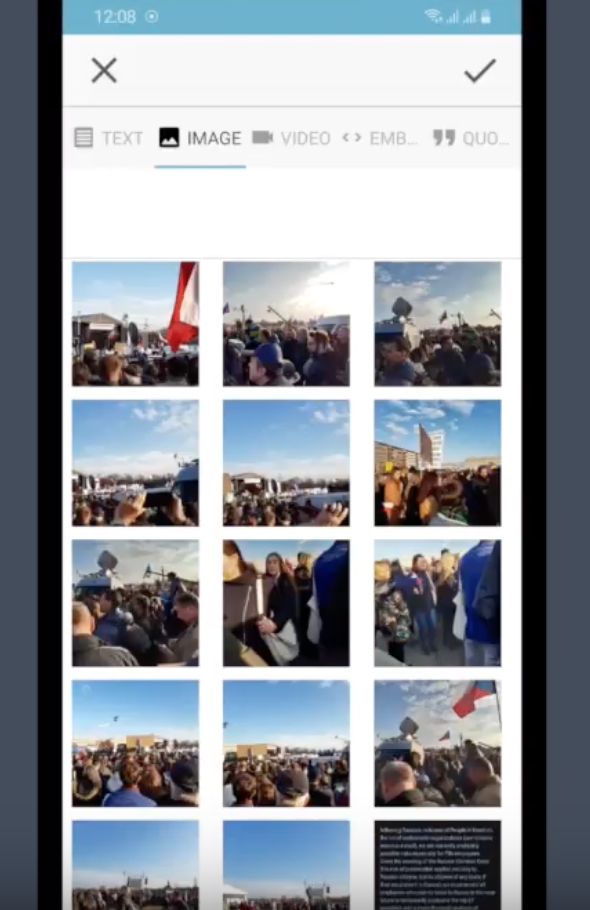
Adding an image
Step 3: Add additional elements
If you want to add additional elements to the post – whether it’s text, images, or videos – click the “plus” sign below the image you just upload.
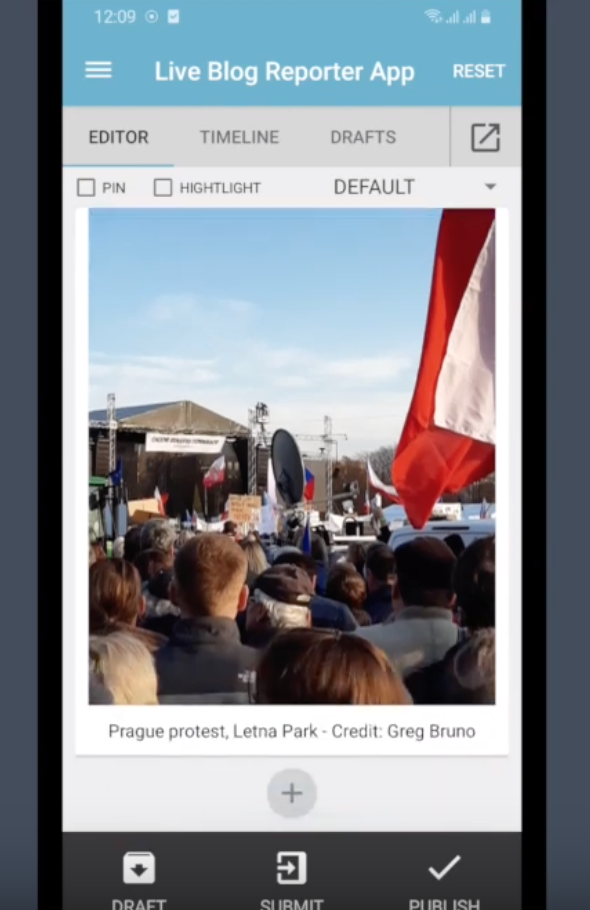
Adding additional elements
Once you’re happy with your post, you can either save it as a “Draft” – a helpful option if you are in an area with weak Internet connectivity – “Submit” it for editorial approval based on your organisation’s workflow, or “Publish” it directly to your Live Blog’s timeline. To see your post in its published form, click the “Timeline” tab at the top of the app. Or visit your blog on the Web.
You can also “Delete,” “Unpublish” or “Edit” a post simply by clicking on it from the “Timeline” view within the App.
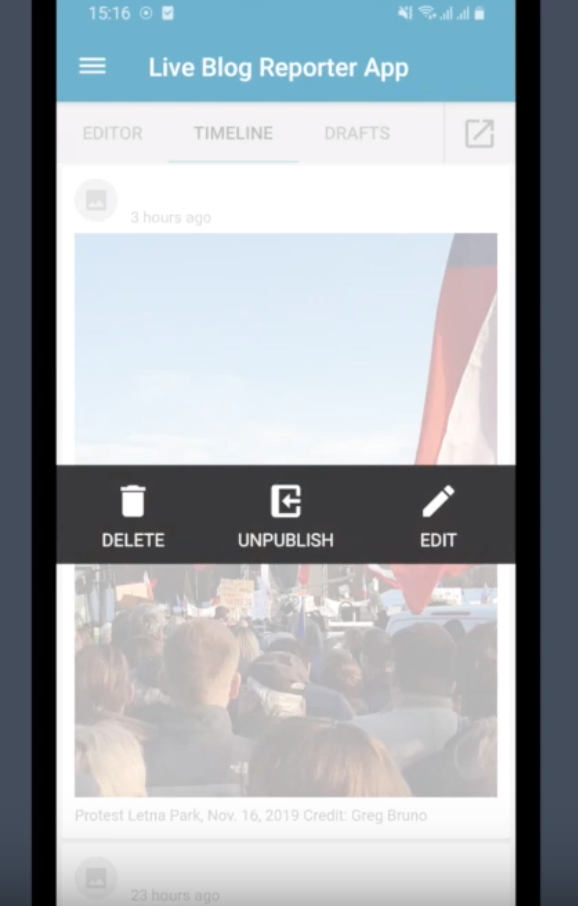
Delete, unpublish or edit
And there you have it. Live blogging on the go is as easy as it’s ever been with the Live Blog Reporter App. For more Live Blog tutorials, check out our YouTube channel or visit us at liveblog.pro.
January 9, 2020
Monetise Your Live Blog With Ads and Affiliate Deals

TIPS AND TRICKS
Monetise Your Live Blog With Ads and Affiliate Deals
by Todd Jatras | Jan. 9, 2020
Today’s most successful news organisations rely on an ever-growing arsenal of digital tools to attract readers and keep them engaged. Live blogging has been around for a while, but is increasingly becoming a key component for news sites in the battle to retain and grow audiences. A blogging platform such as our Live Blog offers a dynamic, feature-rich format that is ideal for covering niche topics or using it to break news then update the story with real-time coverage as events unfold.
There are numerous ways that a well-designed blogging strategy can contribute to the overall health of a site’s news ecosystem, but today we will focus on boosting the bottom line by learning to monetise your blog via ads and affiliate deals.
As a cloud-based, open-source editorial tool that can be embedded in any website, Live Blog offers a host of features such as custom design themes, syndication tools, a mobile app and the ability to easily integrate rich multimedia formats and social media posts into an editorial timeline. Live Blog is highly flexible and scalable, and is used not only by some of the world’s leading news agencies, but also by smaller, independent publishers and even one-person operations. For stories that require frequent updating (elections, sports, conferences, and unexpected events such as natural catastrophes or political uprisings), you’d be hard-pressed to beat its live coverage capabilities. There are also great opportunities to make money from a live blog. You can demo Live Blog for free, and find detailed answers to any questions you may have in our helpdesk.
Complete Control Over Ads on Your Blog
Live Blog supports multiple types of advertising, giving you a great degree of control over what ads appear on your blog. Our advertising manager allows you to build your own native ads and place them within your blog as you see fit. Instead of being tied to third-party ad providers such as Google AdSense or Doubleclick, where you have little control over ads and their placement, these native ads are easy to archive, schedule and populate on a user’s various timelines. Of course, remote ads from those third-party providers can also be thrown into the mix by entering the ad’s code snippet. This gives you the best of both worlds when it comes to ads.
Live blogging also lends itself particularly well to specialised, niche topics, which opens many unique possibilities for native ad selling. To use one example, if one of your blogs is sports related, you could pitch the leagues you cover, sporting goods stores, apparel and equipment manufacturers or even radio and TV networks that broadcast relevant events. Advertisers crave highly targeted audiences and are willing to pay a premium to reach them. With Live Blog you are free to pursue an almost unlimited world of profit opportunity there. Of course, selling ads is a lot of work and requires constant relationship building and maintenance. But it’s a crucial option to have, and it’s also nice to have the option of third-party ads as a fall-back position as you get started.
Affiliate Marketing Pays Dividends
Affiliate marketing is another proven revenue generator, and is practically tailor-made for blogging. Whether your blog’s focus is electronics, fashion, music, books, or many other products, there is a great opportunity to embed affiliate links and promo codes in your product features and receive a commission when a reader clicks through and buys.
Amazon.com is without a doubt the biggest player, and their program lets you promote any of the more than 600 million items on their platform. Some companies have their own affiliate programs and can be approached individually, but the most common approach is to use an affiliate network. Awin and Webgains are two of the majors. They act as intermediaries, connecting companies and affiliates and can save you a lot of time finding the right brand partnerships.
One thing’s for certain, well-produced blogs that thoroughly cover niche topics attract dedicated readers who will keep returning in search of the latest news and reviews of the products they are passionate about. They are also the most likely to read a positive review and decide to purchase on the spot. So, be sure to set up and include affiliate links in your reviews to give your most loyal readers that option.
Combine the Two and Watch Your Revenues Grow
Done together, these two strategies should provide a significant boost for your blog’s bottom line. Of the two, it’s far easier to set up an affiliate program. It can basically be done in a day. And don’t forget, it should also be done retroactively, so all those stellar reviews you’ve already produced can be quickly linked to get the commissions rolling in. As far as advertising goes, this can be a fun-but-time-consuming pursuit, but a creative one that will definitely pay off with persistence and hard work.
October 22, 2019
Live Blogging a Cultural Event with Live Blog

Live Blogging a Cultural Event with Live Blog
by Todd Jatras | October 22, 2019
Live blogging is an excellent way to provide your readers with robust, real-time coverage of cultural events, making use of dynamic elements that give readers the sense that they are live, in-person, with the sights, sounds, smells and tastes of the actual event.
Cultural events take place every day, in all corners of the world; day in, day out, there’s a full slate of festivals, sporting events, conferences, exhibitions, concerts, and more, drawing in the crowds. But there’s also a potentially large online audience, eager for the latest news, updates and experiences that give the feeling of actually being in attendance.
Whether it’s a mega-event like Burning Man or something more along the lines of a local art fair, one of the best ways to produce this kind of “experience” coverage, and assure that interested readers find it, is by blogging.
Traditional formats like the standard newspaper article fall short when it comes to conveying that sense of being there. A digital-native tool like our Live Blog, however, with its multimedia capabilities (photo galleries, video and social media post embeds) and flexibility opens up new dimensions to capture the richness of any experience.
To give you a sense of this, we set out to live blog an arts event ourselves. The Signal Festival is an annual showcase of light-based art and new media works held every autumn in Prague.

